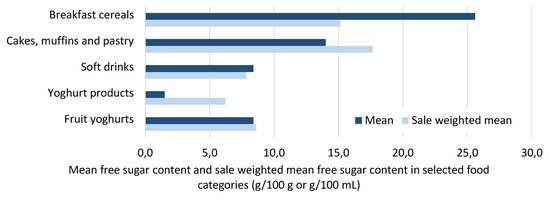Total and Free Sugar Content of Pre-Packaged Foods and Non-Alcoholic Beverages in Slovenia
Abstract
:1. Introduction
2. Material and Methods
2.1. Data Collection
2.2. Identifying Free Sugars within the Ingredient Lists
2.3. Assesment of Total and Free Sugar Content
2.4. Share in Free Sugar Sales
2.5. Sale-Weighted Total and Free Sugar Content
2.6. Statistical Analysis
3. Results
3.1. Proportion of Free Sugar-Containing Products in Different Food Categories
3.2. Median Total Sugar and Free Sugar Content of Packaged Foods and Non-Alcoholic Beverages
3.3. Contribution of Free Sugar to the Total Sugar Content
3.4. Share in Free Sugar Sales
3.5. Correlation of the Free Sugar Content in Foods and Sales
4. Discussion
5. Conclusions
Supplementary Materials
Acknowledgments
Author Contributions
Conflicts of Interest
References
- Bernabé, E.; Vehkalahti, M.M.; Sheiham, A.; Aromaa, A.; Suominen, A.L. Sugar-sweetened beverages and dental caries in adults: A 4-year prospective study. J. Dent. 2014, 42, 952–958. [Google Scholar] [CrossRef] [PubMed]
- Lim, S.; Sohn, W.; Burt, B.A.; Sandretto, A.M.; Kolker, J.L.; Marshall, T.A.; Ismail, A.I. Cariogenicity of soft drinks, milk and fruit juice in low-income african-american children: A longitudinal study. J. Am. Dent. Assoc. 2008, 139, 959–967. [Google Scholar] [CrossRef] [PubMed]
- Warren, J.J.; Weber-Gasparoni, K.; Marshall, T.A.; Drake, D.R.; Dehkordi-Vakil, F.; Dawson, D.V.; Tharp, K.M. A longitudinal study of dental caries risk among very young low SES children. Commun. Dent. Oral Epidemiol. 2009, 37, 116–122. [Google Scholar] [CrossRef] [PubMed]
- Rosier, B.; van Loveren, C.; Zaura, E.; Keijser, B.; Crielaard, W.; Lagerweij, M. Caries incidence in a healthy young adult population in relation to diet. JDR Clin. Transl. Res. 2016, 2, 142–150. [Google Scholar] [CrossRef]
- Sheiham, A.; James, W.P.T. A new understanding of the relationship between sugars, dental caries and fluoride use: Implications for limits on sugars consumption. Public Health Nutr. 2014, 17, 2176–2184. [Google Scholar] [CrossRef] [PubMed]
- Bremer, A.A.; Auinger, P.; Byrd, R.S. Sugar-sweetened beverage intake trends in US adolescents and their association with insulin resistance-related parameters. J. Nutr. Metab. 2009, 2010. [Google Scholar] [CrossRef] [PubMed]
- Malik, V.S.; Popkin, B.M.; Bray, G.A.; Després, J.-P.; Willett, W.C.; Hu, F.B. Sugar-sweetened beverages and risk of metabolic syndrome and type 2 diabetes. Diabetes Care 2010, 33, 2477–2483. [Google Scholar] [CrossRef] [PubMed]
- Montonen, J.; Järvinen, R.; Knekt, P.; Heliövaara, M.; Reunanen, A. Consumption of sweetened beverages and intakes of fructose and glucose predict type 2 diabetes occurrence. J. Nutr. 2007, 137, 1447–1454. [Google Scholar] [CrossRef] [PubMed]
- Perez-Pozo, S.; Schold, J.; Nakagawa, T.; Sanchez-Lozada, L.; Johnson, R.; Lillo, J.L. Excessive fructose intake induces the features of metabolic syndrome in healthy adult men: Role of uric acid in the hypertensive response. Int. J. Obes. 2010, 34, 454–461. [Google Scholar] [CrossRef] [PubMed]
- Te Morenga, L.; Mallard, S.; Mann, J. Dietary sugars and body weight: Systematic review and meta-analyses of randomised controlled trials and cohort studies. BMJ 2013, 346, e7492. [Google Scholar] [CrossRef] [PubMed]
- Welsh, J.A.; Sharma, A.; Cunningham, S.A.; Vos, M.B. Consumption of added sugars and indicators of cardiovascular disease risk among us adolescentsclinical perspective. Circulation 2011, 123, 249–257. [Google Scholar] [CrossRef] [PubMed]
- De Koning, L.; Malik, V.S.; Kellogg, M.D.; Rimm, E.B.; Willett, W.C.; Hu, F.B. Sweetened beverage consumption, incident coronary heart disease, and biomarkers of risk in menclinical perspective. Circulation 2012, 125, 1735–1741. [Google Scholar] [CrossRef] [PubMed]
- Yang, Q.; Zhang, Z.; Gregg, E.W.; Flanders, W.D.; Merritt, R.; Hu, F.B. Added sugar intake and cardiovascular diseases mortality among US adults. JAMA Intern. Med. 2014, 174, 516–524. [Google Scholar] [CrossRef] [PubMed]
- Te Morenga, L.A.; Howatson, A.J.; Jones, R.M.; Mann, J. Dietary sugars and cardiometabolic risk: Systematic review and meta-analyses of randomized controlled trials of the effects on blood pressure and lipids. Am. J. Clin. Nutr. 2014, 100, 65–79. [Google Scholar] [CrossRef] [PubMed]
- Ouyang, X.; Cirillo, P.; Sautin, Y.; McCall, S.; Bruchette, J.L.; Diehl, A.M.; Johnson, R.J.; Abdelmalek, M.F. Fructose consumption as a risk factor for non-alcoholic fatty liver disease. J. Hepatol. 2008, 48, 993–999. [Google Scholar] [CrossRef] [PubMed]
- Assy, N.; Nasser, G.; Kamayse, I.; Nseir, W.; Beniashvili, Z.; Djibre, A.; Grosovski, M. Soft drink consumption linked with fatty liver in the absence of traditional risk factors. Can. J. Gastroenterol. Hepatol. 2008, 22, 811–816. [Google Scholar] [CrossRef]
- Lírio, L.M.; Forechi, L.; Zanardo, T.C.; Batista, H.M.; Meira, E.F.; Nogueira, B.V.; Mill, J.G.; Baldo, M.P. Chronic fructose intake accelerates non-alcoholic fatty liver disease in the presence of essential hypertension. J. Diabetes Complicat. 2016, 30, 85–92. [Google Scholar] [CrossRef] [PubMed]
- Welsh, J.A.; Sharma, A.; Abramson, J.L.; Vaccarino, V.; Gillespie, C.; Vos, M.B. Caloric sweetener consumption and dyslipidemia among US adults. Jama 2010, 303, 1490–1497. [Google Scholar] [CrossRef] [PubMed]
- Stanhope, K.L.; Medici, V.; Bremer, A.A.; Lee, V.; Lam, H.D.; Nunez, M.V.; Chen, G.X.; Keim, N.L.; Havel, P.J. A dose-response study of consuming high-fructose corn syrup–sweetened beverages on lipid/lipoprotein risk factors for cardiovascular disease in young adults. Am. J. Clin. Nutr. 2015, 101, 1144–1154. [Google Scholar] [CrossRef] [PubMed]
- Aeberli, I.; Gerber, P.A.; Hochuli, M.; Kohler, S.; Haile, S.R.; Gouni-Berthold, I.; Berthold, H.K.; Spinas, G.A.; Berneis, K. Low to moderate sugar-sweetened beverage consumption impairs glucose and lipid metabolism and promotes inflammation in healthy young men: A randomized controlled trial. Am. J. Clin. Nutr. 2011, 94, 479–485. [Google Scholar] [CrossRef] [PubMed]
- Stanhope, K.L. Sugar consumption, metabolic disease and obesity: The state of the controversy. Crit. Rev. Clin. Lab. Sci. 2016, 53, 52–67. [Google Scholar] [CrossRef] [PubMed]
- Schillinger, D.; Tran, J.; Mangurian, C.; Kearns, C. Do sugar-sweetened beverages cause obesity and diabetes? Industry and the manufacture of scientific controversy. Ann. Intern. Med. 2016, 165, 895–897. [Google Scholar] [CrossRef] [PubMed]
- World Health Organization. Guidline: Sugars Intake for Adults and Children. 2005. Available online: http://apps.who.int/iris/bitstream/10665/149782/1/9789241549028_eng.pdf (accessed on 17 January 2018).
- Mis, N.F.; Braegger, C.; Bronsky, J.; Campoy, C.; Domellöf, M.; Embleton, N.D.; Hojsak, I.; Hulst, J.; Indrio, F.; Lapillonne, A. Sugar in Infants, children and adolescents: A position paper of the European society for paediatric gastroenterology, hepatology and nutrition committee on nutrition. J. Pediatr. Gastroenterol. Nutr. 2017, 65, 681–696. [Google Scholar]
- Scientific Advisory Committee on Nutrition (SACN). Carbohydrates and Health. Scientific Advisory Committee on Nutrition. Available online: https://www.gov.uk/government/uploads/system/uploads/attachment_data/file/445503/SACN_Carbohydrates_and_Health.pdf (accessed on 17 January 2018).
- Vos, M.B.; Kaar, J.L.; Welsh, J.A.; Van Horn, L.V.; Feig, D.I.; Anderson, C.A.; Patel, M.J.; Munos, J.C.; Krebs, N.F.; Xanthakos, S.A. Added sugars and cardiovascular disease risk in children: A scientific statement from the American Heart Association. Circulation 2017, 135, e1017–e1034. [Google Scholar] [CrossRef] [PubMed]
- Azaïs-Braesco, V.; Sluik, D.; Maillot, M.; Kok, F.; Moreno, L.A. A review of total & added sugar intakes and dietary sources in Europe. Nutr. J. 2017, 16, 6. [Google Scholar] [PubMed]
- Borra, S.T.; Bouchoux, A. Effects of science and the media on consumer perceptions about dietary sugars. J. Nutr. 2009, 139, 1214S–1218S. [Google Scholar] [CrossRef] [PubMed]
- Weaver, D.; Finke, M. The relationship between the use of sugar content information on nutrition labels and the consumption of added sugars. Food Policy 2003, 28, 213–219. [Google Scholar] [CrossRef]
- EC. Regulation (EU) No 1169/2011 of the European Parliament and of the Council of 25 October 2011 on the Provision of Food Information to Consumers. Available online: http://eur-lex.europa.eu/legal-content/EN/TXT/PDF/?uri=CELEX:02011R1169-20140219 (accessed on 17 January 2018).
- Genannt Bonsmann, S.S.; Celemín, L.F.; Larrañaga, A.; Egger, S.; Wills, J.M.; Hodgkins, C.; Raats, M. Penetration of nutrition information on food labels across the EU-27 plus Turkey. Eur. J. Clin. Nutr. 2010, 64, 1379–1385. [Google Scholar] [CrossRef] [PubMed] [Green Version]
- Pravst, I.; Kušar, A. Consumers’ exposure to nutrition and health claims on pre-packed foods: Use of sales weighting for assessing the food supply in Slovenia. Nutrients 2015, 7, 9353–9368. [Google Scholar] [CrossRef] [PubMed]
- FDA. Changes to the Nutrition Facts Label. 2016. Available online: https://www.fda.gov/Food/GuidanceRegulation/GuidanceDocumentsRegulatoryInformation/LabelingNutrition/ucm385663.htm (accessed on 17 January 2018).
- Mis, N.F.; Kobe, H.; Štimec, M. Dietary intake of macro-and micronutrients in Slovenian adolescents: Comparison with reference values. Ann. Nutr. Metab. 2012, 61, 305–313. [Google Scholar]
- Kobe, H.; Štimec, M.; Ribič, C.H.; Mis, N.F. Food intake in Slovenian adolescents and adherence to the Optimized Mixed Diet: A nationally representative study. Public Health Nutr. 2012, 15, 600–608. [Google Scholar] [CrossRef] [PubMed]
- WHO. Adolescent Obesity and Related Behaviours: Trends and Inequalities in the WHO European Region, 2002–2014. Available online: http://www.euro.who.int/__data/assets/pdf_file/0019/339211/WHO_ObesityReport_2017_v3.pdf (accessed on 28 August 2017).
- Ministry of Health of Republic of Slovenia. Resolution on the National Programme on Nutrition and Physical Activity 2015–2025. In Slovenian: Resolucija o Nacionalnem Programu o Prehrani in Telesni Dejavnosti za Zdravje 2015–2025; Ministry of Health: Ljubljana, Slovenia, 2015. [Google Scholar]
- Bernstein, J.T.; Schermel, A.; Mills, C.M.; L’Abbé, M.R. Total and free sugar content of Canadian prepackaged foods and beverages. Nutrients 2016, 8, 582. [Google Scholar] [CrossRef] [PubMed]
- Pravst, I.; Lavriša, Ž.; Kušar, A.; Miklavec, K.; Žmitek, K. Changes in average sodium content of prepacked foods in Slovenia during 2011–2015. Nutrients 2017, 9, 952. [Google Scholar] [CrossRef] [PubMed]
- Nutrition Institute. Podatkovna Baza CLAS Kot Orodje za Vrednotenje Sprememb na Področju Ponudbe Predpakiranih Živil v Sloveniji. Available online: http://www.nutris.org/clas/ (accessed on 17 January 2018).
- Korošec, Ž.; Pravst, I. Assessing the average sodium content of prepacked foods with nutrition declarations: The importance of sales data. Nutrients 2014, 6, 3501–3515. [Google Scholar] [CrossRef] [PubMed]
- Dunford, E.; Webster, J.; Metzler, A.B.; Czernichow, S.; Mhurchu, C.N.; Wolmarans, P.; Snowdon, W.; L’Abbe, M.; Li, N.; Maulik, P.K. International collaborative project to compare and monitor the nutritional composition of processed foods. Eur. J. Prev. Cardiol. 2012, 19, 1326–1332. [Google Scholar] [CrossRef] [PubMed]
- Korošec, M.; Golob, T.; Bertoncelj, J.; Stibilj, V.; Seljak, B.K. The Slovenian food composition database. Food Chem. 2013, 140, 495–499. [Google Scholar] [CrossRef] [PubMed]
- Ng, S.W.; Ostrowski, J.D.; Li, K.-P. Trends in added sugars from packaged beverages available and purchased by US households, 2007–2012. Am. J. Clin. Nutr. 2017. [Google Scholar] [CrossRef] [PubMed]
- Sluik, D.; van Lee, L.; Engelen, A.I.; Feskens, E.J. Total, free, and added sugar consumption and adherence to guidelines: The Dutch national food consumption survey 2007–2010. Nutrients 2016, 8, 70. [Google Scholar] [CrossRef] [PubMed]
- Louie, J.C.Y.; Lei, L.; Rangan, A.M. Reliability of a systematic methodology to estimate added sugars content of foods when applied to a recent Australian food composition database. J. Food Compos. Anal. 2016, 46, 36–42. [Google Scholar] [CrossRef]
- Ng, S.W.; Slining, M.M.; Popkin, B.M. Use of caloric and noncaloric sweeteners in US consumer packaged foods, 2005–2009. J. Acad. Nutr. Diet. 2012, 112, 1828–1834. [Google Scholar] [CrossRef] [PubMed]
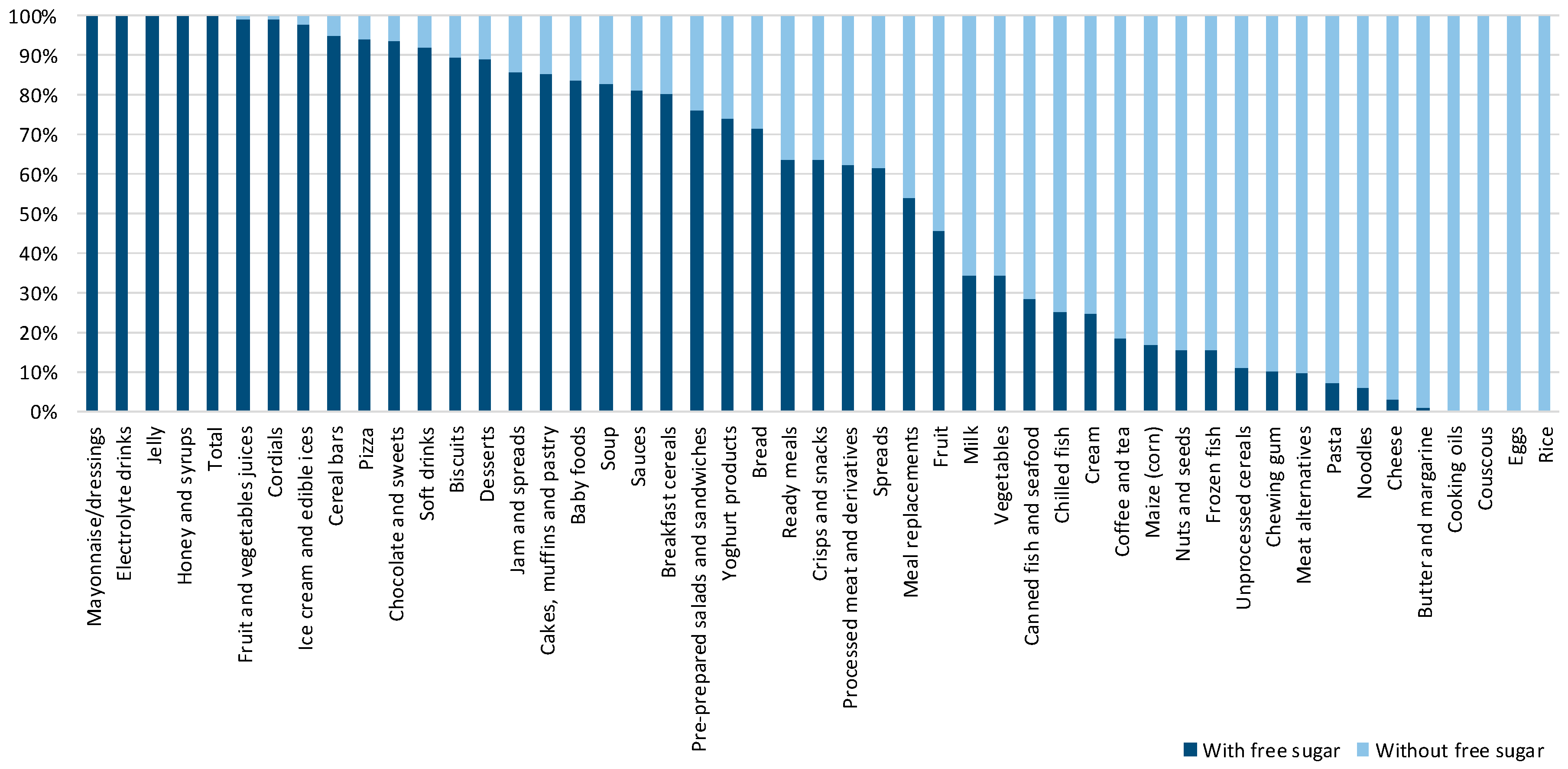
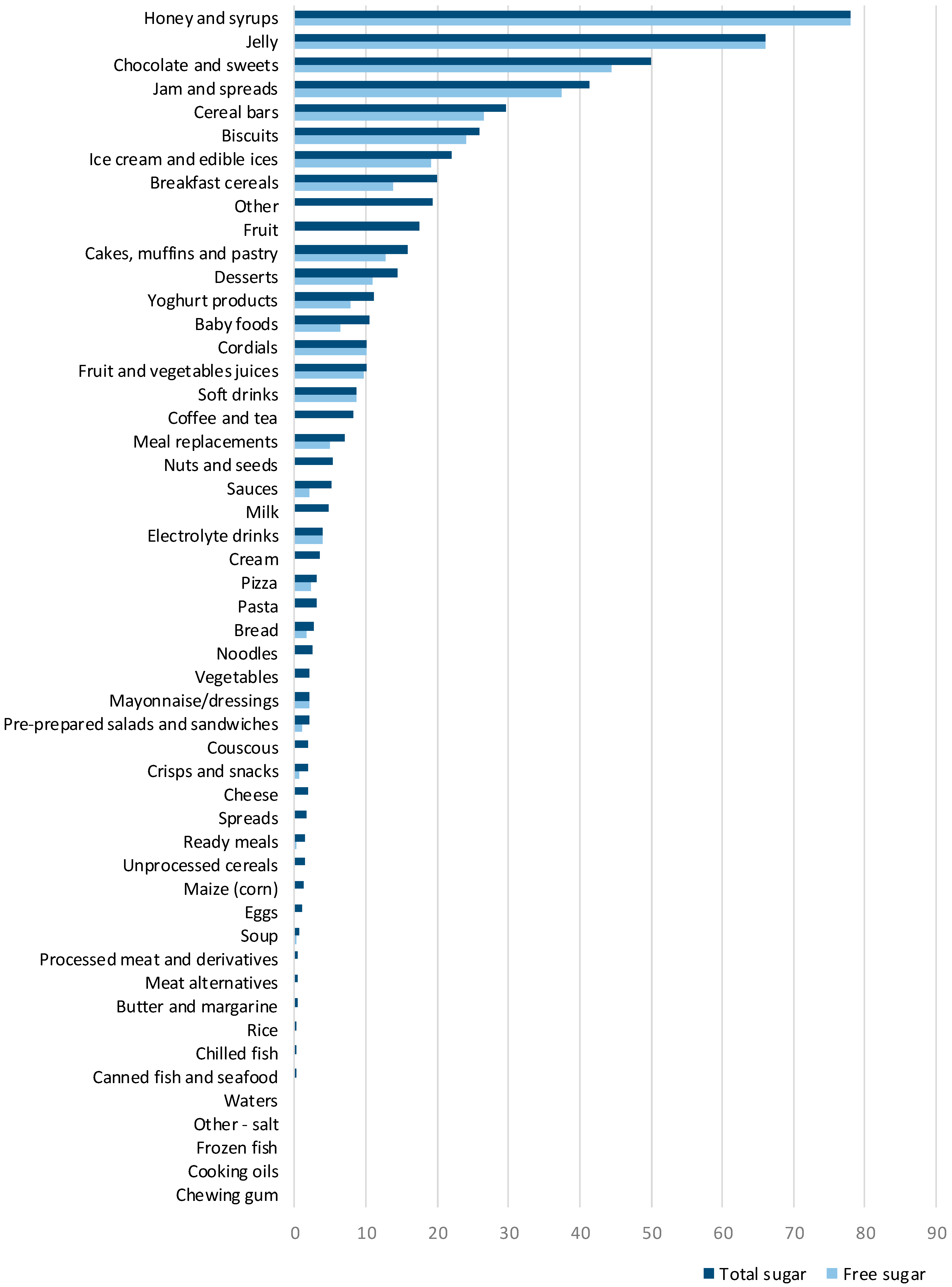
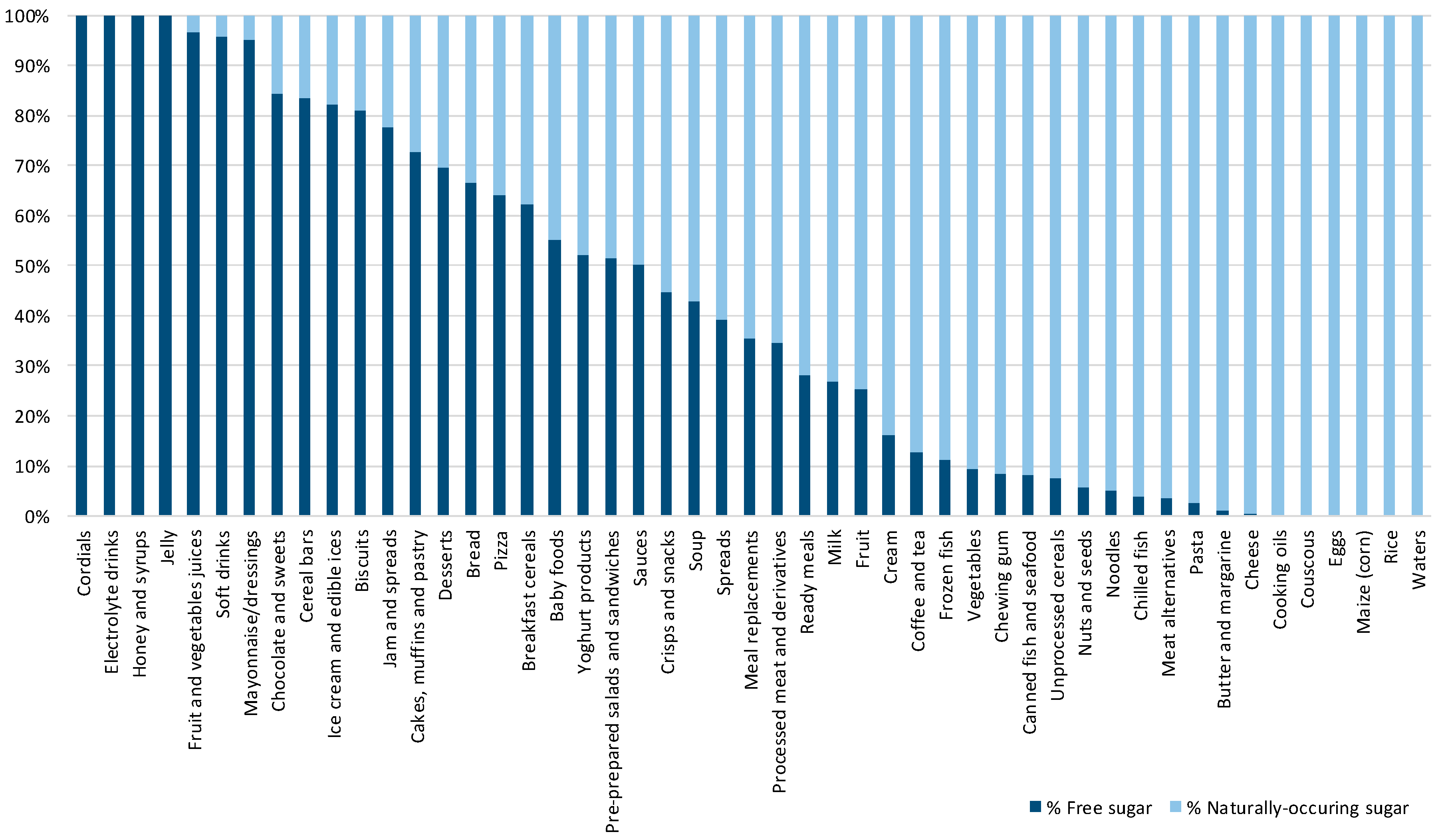

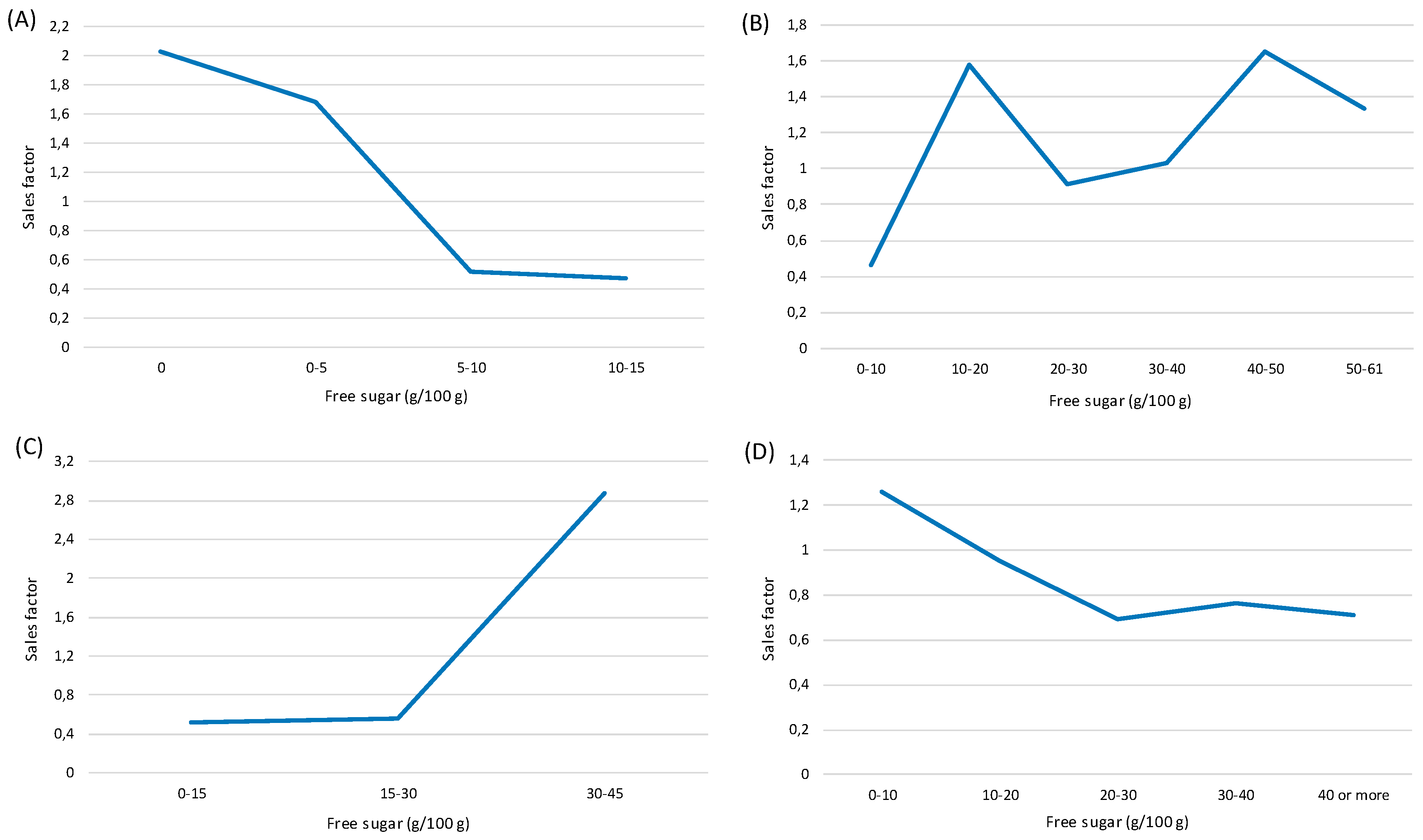
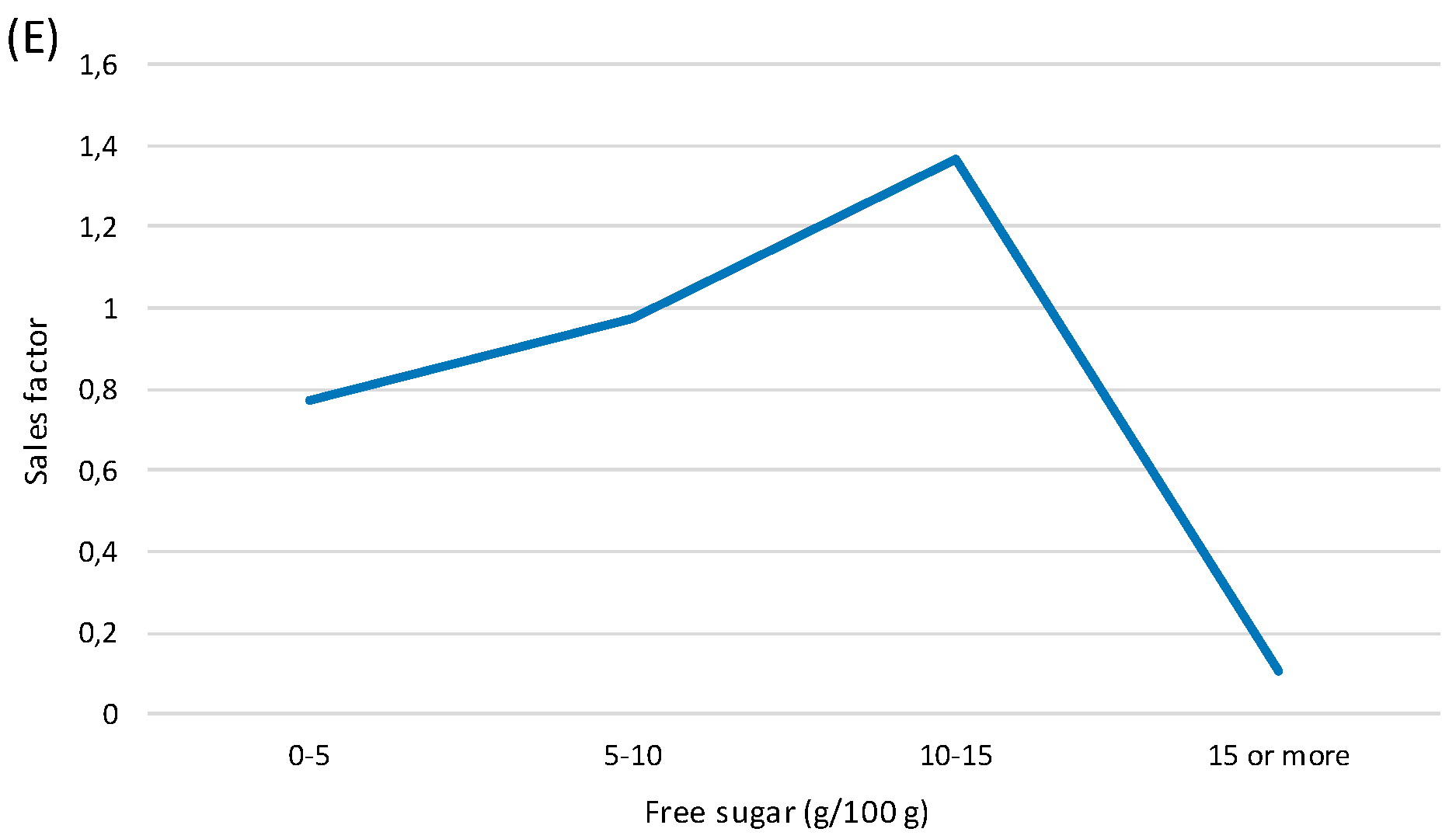
| Step | Description | n (%) |
|---|---|---|
| 1 | Products with 0 g of total sugar as declared on the nutrition facts label. Free sugar value = 0 g/100 g. | 676 (7.2%) |
| 2 | Products that have no FSI listed on the ingredient list. Free sugar value = 0 g/100 g. | 3759 (40%) |
| 3 | Products that contain no ingredients with naturally-occurring sugars. Free sugar value = 100 g/100 g. | 1603 (17%) |
| 4 | Products with detailed lists of ingredients: % of FSI and/or % of ingredients with naturally occurring sugar available. The following formula was used to calculate free sugar content: Total sugar − Calculated naturally-occurring sugar = Free sugar | 942 (10%) |
| 5 | Products that contain free sugar ingredients as well as naturally-occurring sugars and have an unsweetened alternative available in the same category (i.e., sweetened yogurt vs. plain yogurt). The following formula was used to calculate free sugar content: | 873 (9.3%) |
| 6 | Products without unsweetened comparison but with a very similar product for which free sugar value had already been calculated were assigned a value reflective of the proportion of free sugar in the comparing product. | 37 (0.4%) |
| 7 | Products that remained after all the other steps had been performed had their free sugar values estimated based on their lists of ingredients. The following formula was used to calculate free sugar content: Total sugar − Estimated naturally-occurring sugar = Free sugar | 1385 (14.7%) |
| n | Total Sugar (g/100 g or g/100 mL) | Free Sugar (g/100 g or g/100 mL) | Free Sugar (% of Total Sugar) | |||||||||||
|---|---|---|---|---|---|---|---|---|---|---|---|---|---|---|
| Food Category | Mean (SD) | Min | 25th | 50th | 75th | Max | Mean (SD) | Min | 25th | 50th | 75th | Max | ||
| Baby foods | 104 | 13.3 (12.4) | 0 | 8.1 | 10.4 | 11.8 | 53 | 7.2 (7.5) | 0 | 3.7 | 6.4 | 8.7 | 43.3 | 56.2 |
| Biscuits | 736 | 24.6 (15.3) | 0 | 9.5 | 26 | 36.6 | 60.8 | 22.4 (15.2) | 0 | 5.5 | 24 | 35.2 | 60.8 | 81.2 |
| Bread | 161 | 3.1 (2.2) | 0.2 | 1.3 | 2.7 | 4 | 14 | 2.2 (2.3) | 0 | 0 | 1.6 | 3.3 | 14 | 66.5 |
| Breakfast cereals | 297 | 19.2 (12.1) | 0.3 | 9 | 20 | 27.6 | 60 | 14.7 (13.1) | 0 | 1.9 | 13.7 | 23.8 | 57.4 | 62.3 |
| Butter and margarine | 95 | 0.5 (0.8) | 0 | 0 | 0.5 | 0.5 | 5.1 | 0 (0.1) | 0 | 0 | 0 | 0 | 0.5 | 1.5 |
| Cakes. muffins and pastry | 360 | 18.7 (15.1) | 0.2 | 3.6 | 15.8 | 32.8 | 60.7 | 16.5 (15.1) | 0 | 1.8 | 12.8 | 29.5 | 60.3 | 72.8 |
| Canned fish and seafood | 165 | 0.9 (1.4) | 0 | 0 | 0.1 | 1.1 | 7.4 | 0.3 (0.9) | 0 | 0 | 0 | 0 | 5.4 | 12.6 |
| Cereal bars | 61 | 28.4 (12.2) | 5.1 | 22.7 | 29.6 | 34.1 | 69.9 | 23.8 (12.6) | 0 | 15.5 | 26.5 | 30.4 | 67.7 | 83.4 |
| Cheese | 459 | 2.1 (2.6) | 0 | 0.1 | 1.8 | 3.5 | 36 | 0.1 (1.5) | 0 | 0 | 0 | 0 | 32 | 0.5 |
| Chewing gum | 59 | 6.5 (20.9) | 0 | 0 | 0 | 0 | 86 | 6.3 (20.9) | 0 | 0 | 0 | 0 | 86 | 71.4 |
| Chilled fish | 44 | 0.4 (0.8) | 0 | 0 | 0.1 | 0.5 | 3.1 | 0.1 (0.5) | 0 | 0 | 0 | 0 | 3.1 | 5.2 |
| Chocolate and sweets | 1078 | 49.3 (19.2) | 0 | 42.7 | 50 | 58.2 | 99.9 | 44.6 (20.9) | 0 | 36.2 | 44.4 | 55.5 | 99.9 | 87.1 |
| Coffee and tea | 560 | 23.5 (27.3) | 0 | 0.2 | 8.3 | 52 | 92 | 5.5 (16) | 0 | 0 | 0 | 0 | 92 | 12.9 |
| Cooking oils | 126 | 0 (0) | 0 | 0 | 0 | 0 | 0 | 0 (0) | 0 | 0 | 0 | 0 | 0 | 0 |
| Cordials | 92 | 31.9 (32.4) | 0 | 9.2 | 10.1 | 73.2 | 90 | 31.9 (32.4) | 0 | 9.2 | 10.1 | 73.2 | 90 | 100 |
| Couscous | 12 | 1.8 (0.7) | 0.8 | 1 | 1.9 | 2.3 | 2.7 | 0 (0) | 0 | 0 | 0 | 0 | 0 | 0 |
| Cream | 106 | 4.3 (2.9) | 0 | 3 | 3.4 | 4.2 | 15 | 1.5 (3.5) | 0 | 0 | 0 | 0 | 15 | 16.4 |
| Crisps and snacks | 242 | 3 (4.9) | 0 | 1 | 1.8 | 3.4 | 52.3 | 2.1 (4.7) | 0 | 0 | 0.7 | 2.8 | 50.6 | 45.6 |
| Desserts | 182 | 16.2 (8.8) | 0 | 13 | 14.4 | 16.3 | 55 | 12.1 (9.5) | 0 | 8.7 | 10.9 | 13.6 | 55 | 70 |
| Eggs | 22 | 0.8 (0.3) | 0 | 0.9 | 1 | 1 | 1 | 0 (0) | 0 | 0 | 0 | 0 | 0 | 0 |
| Electrolyte drinks | 12 | 9.9 (18.9) | 3.9 | 4 | 4 | 5.1 | 70 | 9.9 (18.9) | 3.9 | 4 | 4 | 5.1 | 70 | 100 |
| Frozen fish | 78 | 0.5 (0.8) | 0 | 0 | 0 | 0.5 | 2.9 | 0.2 (0.6) | 0 | 0 | 0 | 0 | 2.9 | 18.7 |
| Fruits | 248 | 32.7 (24) | 0.1 | 12.3 | 17.5 | 57.2 | 78 | 8.2 (16.5) | 0 | 0 | 0 | 9 | 76 | 25.4 |
| Fruit and vegetables juices | 264 | 9.5 (2.9) | 0.1 | 8.4 | 10 | 11.2 | 17 | 9.1 (3.1) | 0 | 8 | 9.7 | 11.1 | 17 | 96.8 |
| Honey and syrups | 12 | 78 (3.2) | 75 | 75 | 78 | 80.9 | 80.9 | 78 (3.2) | 75 | 75 | 78 | 80.9 | 80.9 | 100 |
| Ice cream and edible ices | 226 | 21.4 (6.1) | 3.4 | 19.7 | 22 | 24.8 | 41 | 18.1 (6.1) | 0 | 15.9 | 19.2 | 21.7 | 37.2 | 82.1 |
| Jam and spreads | 182 | 41.2 (15.7) | 2.5 | 35.5 | 41.4 | 54 | 53 | 35.9 (17.7) | 0 | 31.9 | 37.5 | 49.4 | 60.6 | 77.6 |
| Jelly | 6 | 62.9 (7.4) | 53 | 56.9 | 66 | 67.8 | 70 | 62.9 (7.4) | 53 | 56.9 | 66 | 67.8 | 70 | 100 |
| Maize (corn) | 6 | 1.1 (0.7) | 0.1 | 0.8 | 1.3 | 1.6 | 1.7 | 0 (0) | 0 | 0 | 0 | 0 | 0 | 0 |
| Mayonnaise/dressings | 55 | 3 (2.9) | 0.1 | 1.5 | 2.1 | 3 | 12.2 | 2.7 (2.5) | 0.1 | 1.5 | 2 | 3 | 12.2 | 95.1 |
| Meal replacements | 13 | 21.5 (22) | 4 | 5 | 6.9 | 52.2 | 52.8 | 11.1 (14) | 0 | 0 | 5 | 30.5 | 30.8 | 35.4 |
| Meat alternatives | 61 | 0.9 (1.5) | 0 | 0.2 | 0.5 | 1 | 9.1 | 0.1 (0.4) | 0 | 0 | 0 | 0 | 2.4 | 5.4 |
| Milk | 181 | 6.2 (8.8) | 0.1 | 4.2 | 4.8 | 6.4 | 93.2 | 2.5 (8.3) | 0 | 0 | 0 | 2.8 | 93.2 | 26.9 |
| Noodles | 116 | 2.2 (1.4) | 0 | 1.1 | 2.5 | 3.5 | 6.2 | 0 (0.2) | 0 | 0 | 0 | 0 | 1.1 | 5.7 |
| Nuts and seeds | 174 | 11 (13.7) | 0 | 3.9 | 5.4 | 7.1 | 51 | 2.4 (9.1) | 0 | 0 | 0 | 0 | 51.2 | 5.8 |
| Pasta | 326 | 2.8 (1.5) | 0.2 | 1.7 | 3.1 | 3.6 | 10 | 0.1 (0.5) | 0 | 0 | 0 | 0 | 4.4 | 2.6 |
| Pizza | 33 | 3.2 (1.3) | 0.3 | 2.15 | 3.1 | 4.1 | 5.6 | 2.2 (1.3) | 0 | 1.4 | 2.2 | 3.1 | 4.6 | 64.1 |
| Pre-prepared salads and sandwiches | 46 | 2.2 (1) | 0.7 | 1,4 | 2 | 2.7 | 4.7 | 1.2 (1.2) | 0 | 0 | 1.1 | 2 | 3.5 | 51.4 |
| Processed meat and derivatives | 772 | 0.4 (0.4) | 0 | 0.1 | 0.5 | 0.5 | 3.8 | 0.2 (0.4) | 0 | 0 | 0 | 0.4 | 3.7 | 39.3 |
| Ready meals | 292 | 2.2 (3.1) | 0 | 0.8 | 1.5 | 2.6 | 38 | 0.8 (1.9) | 0 | 0 | 0.1 | 0.8 | 17.7 | 28.2 |
| Rice | 29 | 0.4 (0.4) | 0 | 0.2 | 0.3 | 0.5 | 2.4 | 0 (0) | 0 | 0 | 0 | 0 | 0 | 0 |
| Sauces | 310 | 9.9 (12.1) | 0 | 2.8 | 5.2 | 9.4 | 60.9 | 6.8 (11.5) | 0 | 0 | 2.1 | 5.9 | 60.7 | 52.1 |
| Soft drinks | 381 | 7.7 (3.8) | 0 | 5.6 | 8.6 | 10 | 30 | 7.7 (3.8) | 0 | 5.6 | 8.6 | 10 | 30 | 99.9 |
| Soup | 171 | 0.7 (0.7) | 0 | 0.2 | 0.6 | 0.8 | 4.3 | 0.4 (0.6) | 0 | 0 | 0.3 | 0.5 | 3.9 | 42.8 |
| Spreads | 276 | 13.4 (21.2) | 0 | 0.6 | 1.6 | 9.5 | 64.3 | 8.7 (17.9) | 0 | 0 | 0 | 2.7 | 58.5 | 39.3 |
| Unprocessed cereals | 110 | 2.12 (2.18) | 0.2 | 0.9 | 1.46 | 2.4 | 15 | 0.3 (1) | 0 | 0 | 0 | 0 | 4 | 7.5 |
| Vegetables | 530 | 3 (4.1) | 0 | 0.25 | 2.1 | 3.9 | 26.5 | 0.54 (1.6) | 0 | 0 | 0 | 0 | 13.7 | 9.7 |
| Waters | 82 | 0 (0) | 0 | 0 | 0 | 0 | 0 | 0 (0) | 0 | 0 | 0 | 0 | 0 | 0 |
| Yogurt products | 449 | 10.2 (4.3) | 0 | 5.3 | 11.1 | 13.1 | 20.8 | 6.5 (4.7) | 0 | 0 | 7.9 | 10.1 | 17.1 | 52.3 |
| Total | 10,407 | 15.1 (19.7) | 0 | 1.2 | 5.5 | 22 | 99.9 | 10.3 (17.7) | 0 | 0 | 0.3 | 11 | 99.9 | 57.5 |
© 2018 by the authors. Licensee MDPI, Basel, Switzerland. This article is an open access article distributed under the terms and conditions of the Creative Commons Attribution (CC BY) license (http://creativecommons.org/licenses/by/4.0/).
Share and Cite
Zupanič, N.; Miklavec, K.; Kušar, A.; Žmitek, K.; Fidler Mis, N.; Pravst, I. Total and Free Sugar Content of Pre-Packaged Foods and Non-Alcoholic Beverages in Slovenia. Nutrients 2018, 10, 151. https://doi.org/10.3390/nu10020151
Zupanič N, Miklavec K, Kušar A, Žmitek K, Fidler Mis N, Pravst I. Total and Free Sugar Content of Pre-Packaged Foods and Non-Alcoholic Beverages in Slovenia. Nutrients. 2018; 10(2):151. https://doi.org/10.3390/nu10020151
Chicago/Turabian StyleZupanič, Nina, Krista Miklavec, Anita Kušar, Katja Žmitek, Nataša Fidler Mis, and Igor Pravst. 2018. "Total and Free Sugar Content of Pre-Packaged Foods and Non-Alcoholic Beverages in Slovenia" Nutrients 10, no. 2: 151. https://doi.org/10.3390/nu10020151






